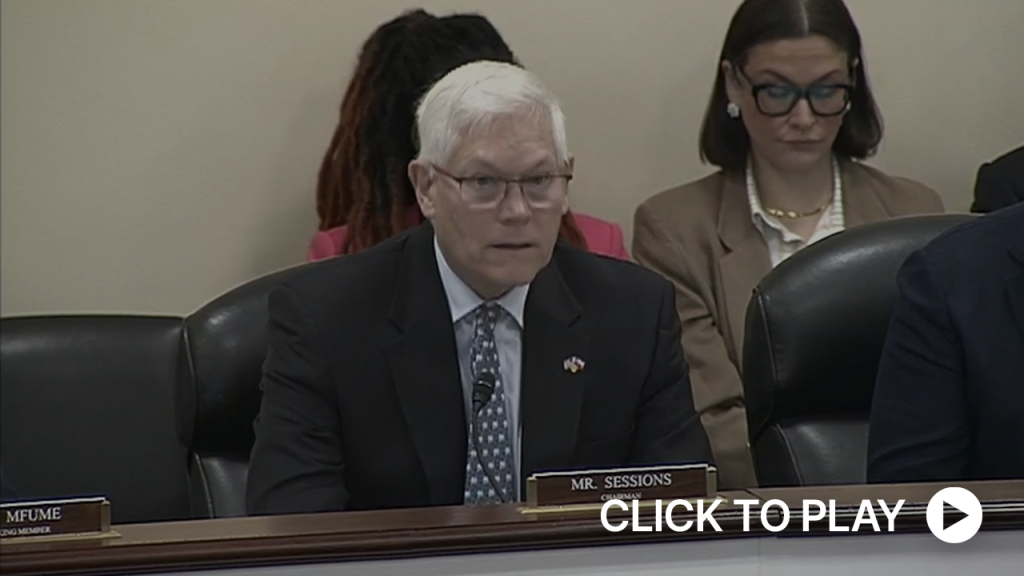
Sessions Opens Hearing on the Department of Defense’s Fraud Risk Management
WASHINGTON—Subcommittee on Government Operations Chairman Pete Sessions (R-Texas) delivered opening remarks at today’s hearing on “Safeguarding Procurement: Examining Fraud Risk Management in the Department of Defense.” In his remarks, Subcommittee Chairman Sessions noted that the Department of Defense (DOD) has reported billions of dollars lost to fraud in the last seven years and that the Department has been unable to account for how much money it spends annually or where its assets are held. At today’s hearing, the panel will examine strategies to combat fraud and will hear from DOD Inspector General and U.S. Government Accountability Office witnesses on steps the DOD is taking to address these problems.
Below are Subcommittee Chairman Sessions’s remarks as prepared for delivery.
Welcome to today’s hearing on the Department of Defense’s fraud risk management efforts to combat contracting fraud.
In 2024, DOD officials told the GAO that they didn’t believe there was much fraud within their department relative to their overall spending.
Reports show that DOD spends over $1 trillion annually.
Even a small percentage of that amount is significant.
From 2017 through 2024, DOD reported about $10.8 billion in confirmed fraud.
This figure mostly relies on dollars that were recovered.
According to GAO, confirmed fraud and the amount recovered may only reflect a small fraction of the extent of fraud within DOD.
To accomplish its global mission, DOD relies on contractors for goods and services.
In fiscal year 2023, DOD reported that about $431 billion or 71 percent of total defense spending went to contracts for various products and services.
Seventy-one percent.
For years, GAO and others have reported that DOD has struggled to accurately account for the government property that contractors possess.
This long-standing issue affects the DOD’s ability to produce fully auditable financial statements as we have discussed in previous hearings.
It affects our ability to ensure that taxpayer money is being spent appropriately, and our service members are getting what they need.
It affects our ability to prevent bad actors from exploiting vulnerabilities in the contracting system.
There have been some notable cases over the years that highlight how far fraudsters will go to line their pockets by defrauding the federal government.
In the early 2000s, Fat Leonard orchestrated the worst corruption scheme in U.S. naval history.
He bribed Navy officers to steer business towards his company Glenn Defense Marine Asia.
This company offered services to U.S. Navy ships and overcharged the Navy by at least $35 million.
This scheme went on for over a decade.
This case is still being investigated so the full scope of damage is not known.
As far back as 2006, Navy criminal investigators opened and closed 27 separate investigations into Glenn Defense Marine Asia.
GAO recently reported that DOD’s updated fraud risk management strategy does not include data analytics.
Data analytics would make it easier for personnel to verify information and determine eligibility for contractors to receive federal awards.
It would also help connect the dots between suspicious activities.
Had investigators and DOD contracting personnel used data analytics back in 2006, Fat Leaonard could have been stopped years ago.
Examples like this are horrible, but fraud within the Department doesn’t just threaten DOD’s financial position.
There are real operational impacts that can pose a threat to our servicemembers.
One such closed case from the Defense Criminal Investigative Service involved a fraudster who purposefully falsified documents.
These documents included a fraudulent certificate to conceal the fraudster’s company’s failure to maintain required manufacturing standards for a machine gun part.
The financial impact was only about $124,000 but the non-financial impact was even more troubling.
A military engineer tested one of these machine gun parts and saw several deficiencies.
These deficiencies could have caused harm to our warfighters.
Our sons and daughters fighting for our country should not have to worry about whether or not a contracted part for their weapon will function correctly.
This Subcommittee is committed to continuing conversations that will have real impact on how the government does business and how agencies can save taxpayer money.
One of our first hearings this Congress was focused on preventing fraud rather than chasing fraudsters who have already run away with taxpayers hard earned dollars.
Shining a light on contracting fraud within DOD and highlighting some commonsense strategies that can prevent this fraud continues this conversation.
Estimating the amount of fraud within DOD is a hard task but I’m hopeful that this conversion—a first of many—will be a step in the right direction.
We will get closer to answering the question of—what is the scope of this problem and what can DOD do better to solve it.
I look forward to hearing from our knowledgeable witnesses.
Distribution channels: U.S. Politics
Legal Disclaimer:
EIN Presswire provides this news content "as is" without warranty of any kind. We do not accept any responsibility or liability for the accuracy, content, images, videos, licenses, completeness, legality, or reliability of the information contained in this article. If you have any complaints or copyright issues related to this article, kindly contact the author above.
Submit your press release
